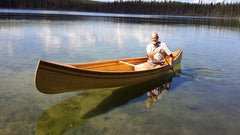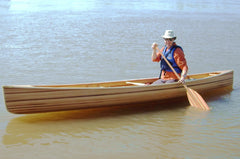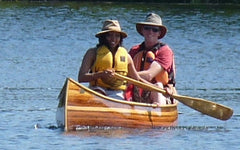My Canoecraft Story or How it all Got Started by Bob Arthur, Wainfleet, ON, Canada
Posted on January 15 2014

By Bob Arthur
When I was a kid, we used my Dad's already vintage ribbed cedar strip canoes. We were building a concrete wall along our Lake Ontario shoreline and we used them to haul tons of rocks from further down the shore. This was besides fishing and playing. Alas, they were stolen when I was a teenager and I've been looking for them ever since. Anybody seen them floating off Port Dalhousie? I always wanted another one.
So . . . around 1992, after buying Ted's CanoeCraft and reading it cover to cover, I decided I was confident enough to try and reproduce one of our stolen canoes. Since our cottage was beside Lake Ontario, I chose to build the Sunnyside Cruiser, a big water canoe. I was on a rather tight budget so instead of ordering plans, I took Ted's information on the Sunnyside from the book, used the XY lofting info on my computer drawing program sizing it up to 18', and then printed out a 1/12 scale model to test the process. The lines looked great and just to really test it, I built 1/12 model stations and then I built an 18" canoe on them. (See the picture.)
Still on that tight budget, I hunted for four good 20' cedar boards for my first project, ripped them, put on bead and cove and set up the strongback in the cottage back yard. This would be an open-air project. My goal was to not use staples and a method slowly evolved in my mind. Summer No 1, I put on the first three strips using bricks and buckets of water as weights to hold them snuggly together. Didn't seem like I got much done that summer, but then there was this constant parade of neighbors coming by wondering: "Watcha doin' Bob?" and "You gonna get it done this year?" and "D'you know what you're doing Bob?" and "Are you sure that's going to float?" Summer ended, so I bundled it up and over the winter, I made the hi-lite strip.
Spring came again, as it usually does, and during Summer No. 2, I continued stripping the boat but my method had changed. I moved to C-clamps and wedges to replace the weights. More strips went on, including the hi-lite strip. More visits from neighbors: "Aren't ya done yet Bob?" and "It's still got a big hole in the middle".
Summer No. 3, I got nothing done because the weather was too awful and the comments were: "Not working on your canoe anymore eh Bob?" However, it was not time wasted because I spent time at Ron Frenette's Canadian Canoes workshop learning how to fibreglass by helping him glass a canoe.
Summer No. 4. From the neighbors: "Ya gonna finish it this year Bob?" and "What are you doing now?" Well, I closed the hull in and glassed and finished the canoe. I installed painter holes, bow and stern, in my unique decks designed to deflect the big lake waves. I took the canoe to a boat builder in Port Sandfield, Muskoka, for final varnishing. Being a carver, I created a very unique yoke for carrying my new 18' Sunnyside Cruiser up and down the 72 steps to the lake. It was completed and launched in Lake Ontario in 1994 and somewhere along the way, I discovered that I had actually created a reproduction of one of the stolen canoes. The old lee-boards, mast step and mast fit my new canoe as if they had been made for it. The Sunnyside had quite a reputation as a "girling" canoe and for being very fast (on the water!). The neighbors had nothing more to say. I had done it. I couldn't wait to try it and you'll note the temporary thwarts held on with C-clamps in the picture. Finished weight--64 lb., and compared to the 105 lbs. of the stolen one, was much easier to carry.
Around 1994, we moved to Wainfleet, Ontario, on Lake Erie, where thankfully our lake bank was much lower. A carving friend, Brian Heaslip, was impressed with my canoe and encouraged me to get involved with him to build Prospector canoes to raffle as a fund raiser for the annual Labor Day Marshville Heritage Festival. Since then, Brian and I formed a partnership that we call Big2Canoe and continue building these canoes, improving our stapleless method and teaching our methods to dozens of students. Over the years, we have built over 20 canoes through classes and as Marshville fundraisers. The picture shows one of our finished products. Yes, it floats!
The basis of our construction is taken from Ted Moore's CanoeCraft book and is required reading by our students. The only real difference is, we don't use staples. Ron Frenette of Canadian Canoes and Ted and Joan of Bear Mountain have been such a help and freely give of their information and resources, which helps us pass their techniques along.





